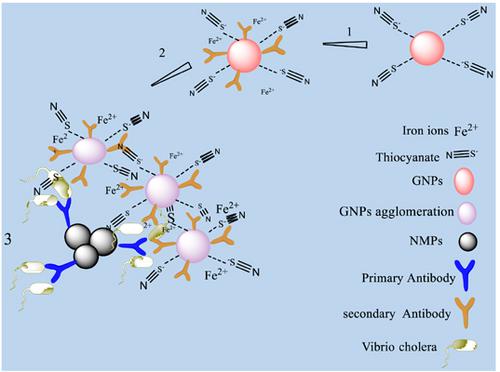Current Nanoscience ( IF 1.5 ) Pub Date : 2020-09-30 , DOI: 10.2174/1573413716666191230154316 Naimeh Mahheidari 1 , Jamal Rashidiani 1 , Hamid Kooshki 1 , Khadijeh Eskandari 1

|
Background: Today, nanoparticles hold great promise in biomedical researches and applications including bacteria detection. The rapid and sensitive outcomes of bacteria detection strategies using nanoparticle conjugates become determinative, especially in bacterial outbreaks. In the current research, we focused on detecting V. cholera bacteria and its toxin using a thiocyanate/Au nanoparticle. Thiocyanate adsorbed strongly on the surface of gold nanoparticles and changed the surface by enhancing surface plasmon resonance of gold nanoparticles.
Objective: This method is tried to introduce a simple and fast procedure to assay vibrio cholera. So, it is observed by the naked eyes as well.
Methods: We used two antibodies (Ab) for V. cholera detection: a) a primary antibody conjugated to magnetic nanoparticles (MNPs) for trapping V. cholera bacterial cells, and b) a secondary Abconjugated thiocyanate-GNPs as a colorimetric detector. Then, an immuno-magnetic separation system connected to a colorimetric assay was designed based on the GNPs. The results were measured by ultraviolet-visible (UV-Vis) spectroscopy.
Results: The results showed that gold nanoparticles are an appropriate optical assay for detecting biological samples in a minimum concentration and also it can be easily seen by the naked eyes. The linear range of this biosensor is 3.2×104 to 28×104 cells per ml.
Conclusion: In this research, a colorimetric immune assay based on gold nanoparticles was designed to improve the sensitivity of V. cholera detection. Also, this method can be used for the detection of other biological agents.
中文翻译:

努力研制用于霍乱弧菌检测的比色纳米生物传感器
背景:如今,纳米颗粒在包括细菌检测在内的生物医学研究和应用中具有广阔的前景。使用纳米颗粒结合物进行细菌检测的快速而灵敏的结果具有决定性,特别是在细菌爆发中。在当前的研究中,我们致力于使用硫氰酸盐/ Au纳米颗粒检测霍乱弧菌细菌及其毒素。硫氰酸盐强烈吸附在金纳米颗粒的表面上,并通过增强金纳米颗粒的表面等离子体共振来改变表面。
目的:试图通过该方法引入一种简便,快速的霍乱弧菌测定方法。因此,它也可以用肉眼观察到。
方法:我们使用了两种抗体(Ab)进行霍乱弧菌的检测:a)与磁性纳米颗粒(MNPs)结合的一级抗体,用于捕获霍乱弧菌细菌细胞,以及b)作为比色检测器的二级结合的硫氰酸盐-GNP。然后,基于GNP设计了与比色法连接的免疫磁分离系统。通过紫外可见(UV-Vis)光谱法测量结果。
结果:结果表明,金纳米颗粒是检测最低浓度生物样品的合适光学检测方法,并且可以通过肉眼轻松看到。该生物传感器的线性范围是每毫升3.2×104至28×104个细胞。
结论:在这项研究中,设计了一种基于金纳米颗粒的比色免疫测定法,以提高霍乱弧菌检测的灵敏度。同样,该方法可用于检测其他生物制剂。



























 京公网安备 11010802027423号
京公网安备 11010802027423号